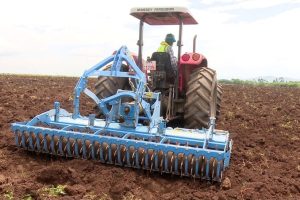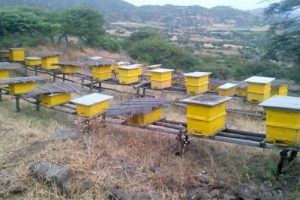
Of the various sectors on which Ethiopia has been embarking, chicken production, poultry, is showing progress as it has been widely run in different parts of the nation.
The Ethiopian Herald approached Zinabu Zewudu, an agro economist graduated from Dilla University, to garner professional comment on the agriculture sector in general and the poultry subsector in particular centering Ethiopian poultry farming methods, their contributions, and challenges such as feed shortages, disease, veterinary service, health management, genetic quality etc.
He said, “Obviously, Ethiopian chicken breeds have been using for meat and egg production. In the country, both types of chicken egg-laying and meat producing varieties are known as dual-purpose breeds. The generations are then utilized to produce eggs, while the parent stock is employed in the hatchery. It is well recognized that poultry plays a significant socioeconomic importance in terms of bolstering food security, supplementary financial flow, and job creation. Of course, rural chicken generates the vast majority of national egg and chicken meat output, and is a substantial part of the national economy in general and the rural economy in particular. Village chicken-raising is the practice of maintaining chickens in rural households employing family effort, too.”
Village chicken has a considerable impact on the national economy of the nation as well as its role in improving the nutritional status, income, food security, and livelihood of many smallholders due to its low cost of production he said adding that poultry remains an important part of farming systems and household economies in rural communities, while large and small-scale commercial poultry industries in cities and towns play a critical role in providing safe, high-quality products for urban consumers.
As to him, poultry production is used to provide employment and income-generating opportunities and priorities animal for holy days and religious celebrations.
Zinabu further elucidated that the government is now working on poultry production options include training and extension services, veterinary services, market access, financial services, preparing forage, and the requirement for limited space and inputs. As a result, certain actions are being taken immediately to alleviate these limits and boost the poultry’s production potential.
Scientifically speaking, he said all domestic birds, such as chickens, turkeys, ducks, geese, ostriches, guinea fowls, and pigeons, are considered poultry. Because other forms of poultry are essentially unknown as sources of egg and meat, the term poultry is identical to domestic chicken. Ethiopian chickens are the most common, with chickens being owned by almost every rural family. They provide a crucial source of protein and revenue for the family.
“Chicken production is vital for developing countries, like ours, socioeconomic development. Poultry, particularly chickens, is the most extensively kept subsector and the Ethiopian poultry population (chicken) is composed of indigenous, hybrid, and foreign breeds.”
As to Zinabu, chicken farming is a significant and fundamental element of most households in Ethiopia, as it is in other poor nations, in rural, urban, and vicinity settings, allowing farmers to reap the advantages of high-quality protein in the form of eggs and meat while simply scavenging feed resources. Chickens are raised in free-range systems in most villages, with the majority of their diet coming from scavenging insects, maggots, plant materials with very tiny amounts of grain crop and table waste supplements from the home.
Fertile eggs, table eggs, day-old chicks, broiler meat, and adult breeding stocks are provided by large-scale commercial poultry to small-scale modern poultry farms. It is distinguished by a higher degree of productivity, as chicken production is fully market-driven to meet the strong demand for chicken in major cities, and it employs a diverse workforce ranging from chicken attendants to professional managers.
According to Zinabu, Egg and poultry meat are the ones that provide critically important nutrients, including protein, minerals and vitamins. In addition to being used as an income source, small-scale poultry production contributes to ensuring food and nutrition security of the poor people. Chickens, in many households, are kept by women and the youths, providing employment and means of increasing family economic gains.
He also said that chicken production is an important economic venture which considers both genders male and female. Chicken keeping is also mostly done by individuals with primary education, who rely on them as sources of income and protein and the variations of the same between/among districts.
True, he added poultry keeping remains an important economic option for improving the livelihoods poorer smallholders across the nation. Increasingly stringent quality and food-safety standards demanded by importing countries will favor the intensification process.
“The poultry farming is of paramount importance in reducing poverty, achieving food and nutritional security, contributing to economic growth (GDP) and agro-industry development, making a significant contribution to exports and foreign exchange earnings and supports to climate resilience.”
Zinabu further elucidated that success in modernizing the poultry sub-sector will also require policy interventions that help ensure sufficient land that needs to be allocated and put into poultry feed production, especially maize and soybean, and the private sector is encouraged to invest in poultry agribusinesses—especially day-old chick production and meat and egg processing.
As to him, special incentives are needed, like review of the business climate, tax facilities, training, to promote more value adding through processing and product transformation combined with clearer roles of the public and private sectors.
As stated earlier and witnessed so far, poultry plays a significant socioeconomic importance in terms of food security, supplementary financial flow, and religious/cultural reasons as it is a substantial part of the national economy in general and the rural economy in particular. Due to its low cost of production, village chicken has a considerable impact on the national economy of Ethiopia and other developing nations, as well as its role in improving the nutritional status, income, food security, and livelihood of many smallholders.
He said, “Yes, poultry remains an important part of farming systems and household economies in rural communities, indeed. As proved scientifically, poultry meat and eggs benefit the human population by providing meals with high-quality protein and low-fat levels with optimal fatty acid profiles.”
It is well recognized that he added the poultry industry sector has a large number of firms competing over low prices with low profit margins, leading to immense pressure by firms to cut costs. At the same time, to remain competitive and meet production and consumption targets, firms are expected to build capacity with a view to dramatically increasing production—raising more and more birds in confined spaces.
Population growth, rising income and urbanization are commonly seen as the main drivers of poultry demand, in fact, he said adding that, however, government policy choices, growth and marketing of quick service restaurants and super markets, food safety concerns, costs of production such as labor, land and feed, and environmental limitations including feed, land and water constraints have and will continue to shape demand in the livestock sector and poultry is no exception.
As to him, food safety concerns, in turn, are driving the government and consumers to demand greater control of the supply chain, slowly shifting consumer habits towards more processed poultry bought in supermarkets.
He further added that improved processing technologies and ready-to-eat poultry products are expected to be provided to customers and users for the purpose of quenching consumer interest in poultry products in the country. Poultry operators, various companies, associations working on the area, have to focus on expending food processing facilities and investing in advanced technologies to produce the, three RS: ready-to-use, ready-to-cook and ready-to-eat foods.
According to Zinabu, poultry production in Ethiopia continues to slowly grow, as a lot remains to be done to promote it, and production of poultry meat is set to rise.
From an industry standpoint, he said all operators can always do a better job of communicating the positive aspects of the industry, and the poultry economic impact.
“The poultry industry has provided citizens, especially the farming community, with job opportunities, national revenue and other related entities. The poultry industry supports a number of rural communities thereby contributing a lot to economic growth.”
BY MENGESHA AMARE
THE ETHIOPIAN HERALD TUESDAY 6 FEBRUARY 2024





